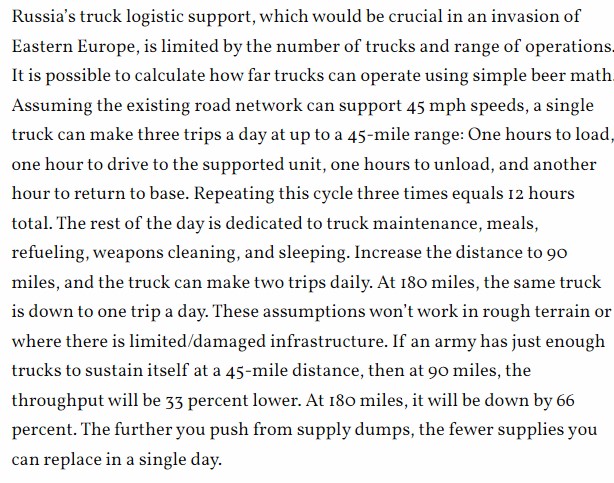The Russian army's Ukraine logistics would be familiar to its veterans who fought in WWII - or even WWI. It involves trains, trucks and human effort. There are no 'force multipliers' like forklifts, enhanced packaging or mechanical aids.
The longer range rockets such as the US HIMARS system with which Ukraine is now supplied means that they are able to strike more deeply into the Russian logistics supply chain, further disrupting and delaying delivery of crucial ammunition - already slowed by Russia's own indiscriminate initial bombing of infrastructure. JL
Trent Telenko reports in Twitter:
The Russian Army doesn't use mechanized logistics 'enhancers' to move its ammo & supplies. It is taking a whole day to do one round trip resupply run to a range of 90 km, not 90 miles. (And) blown up bridges require longer truck by-pass logistical routes. Infrastructure destroyed by Russian artillery plus the utter lack of mechanized logistics yields much different truck logistics. GMLRS will push Russian trucks outside their one-day, round trip, supply range. Once Ukraine works through the most critical artillery depots on it's list it will use all its newly acquired deep strike assets to slam Russian ammo supply trainsThe passage I've clipped here was the heart of the November 2021 advanced Western understanding of Russian logistics. The problem with the passage below is everything Alex Vershinn stated as a 'beer math' model of Russian truck logistics is horribly wrong. Vershinn, like every other Western logistician, was blindsided by the 80 year/four generation Western intelligence failure to notice the Russian Army doesn't use mechanized logistics 'enhancers' to move its ammo & supplies. The Russian Army has no pallets, no forklifts nor any ISO containers.
Vershinn's assumption that six hours of work day will fill & empty three truckloads of supplies in a 24 hour work day needs to be divided by 3 or 4 due to the lack of pallets & all terrain forklifts Moving ammo packaged thus by hand takes longer. I've talked to Ukrainian soldiers in the Twitter space & it is taking a whole day to do one round trip resupply run to a range of 90 km, not 90 miles. While Alex Vershinn mentioned in passing that damage to infrastructure invalidated his 'beer math,' expanding...a bit on what 'infrastructure damage' means is required. When people on Twitter think of destroying bridges in Ukraine, they think like (western Europe or the US). (But) lots of little places where creeks or water drainage culverts go under the roads. Any one of those blown up, see photo, require longer truck by-pass logistical routes.Infrastructure destroyed by Russian artillery plus the utter lack of mechanized logistics yields much different truck logistics 'beer math.' 1. 90 km on Ukrainian artillery ravaged roads is minimally a 2 hour drive one way or 4 hours on the road round trip.
Since Russian trucks need to be loaded by hand, you are looking at least 3 hours to load & a further 3 hours to unload. 3. Add in needed break times for the drivers, etc. & 1 Russian tactical truck can do 1 supply run a day to between 60% & 75% the radius of action. ...that 'FEEDING THE BEAR' beer math laid out, call it 30% of Vershinn's logistic capability model. This has huge implications given the Ukrainian artillery depot interdiction campaign.According to the US Army Chief of Staff, the latest versions of US GMLRS that Ukrainian HIMARS fire reach out to at least 85 km to hit within the various OSINT circular error probabilities of 3-to-7 meters.Effectively, GMLRS will push Russian tactical trucks outside their sustained one-day, round trip, supply range. This means Russia is going to have to rely far more on railways than it has to date. And the Russians have been relying more and more on railways. The easiest way to get around reduced truck supply lift is to 'bomb up' your tanks, AFV's and artillery at railway siding.Or simply base, resupply & fire your longest ranged & most logistically intensive rocket artillery from railway siding.Once Ukraine works through the most critical artillery depots on it's list. It will use all its newly acquired deep strike assets to slam Russian ammo supply trains like in those retweets.Russian ammo trains in range of GMLRS are a whole lot easier to find & strike than tactical trucks. Plus, when detonated, extensive train clearance & EOD removal will have to happen before the rail lines line can be used again. GMLRS means Russian logistics is hosed.





















4 comments:
You have done great work by publishing this article here. It is useful and convenient info for us. Crossdock Service in Miami Keep upgrading our knowledge by share these types of articles.
I just want to remark that the information you shared about hoodies is well-informed. It is a worthwhile and interesting essay for us. Keep sharing this kind of information, I appreciate it.international freight forwarders
You are sharing a piece of nice information here. The information you have given is genuinely instructive and gigantic for us. Appreciation for sharing an article like this.Freight Companies In Miami
I for the most part check this sort of caution post and I found your article which is associated with my benefit. This is a phenomenal strategy for extending data for us. Appreciation for sharing an article like this.international freight logistics
Post a Comment